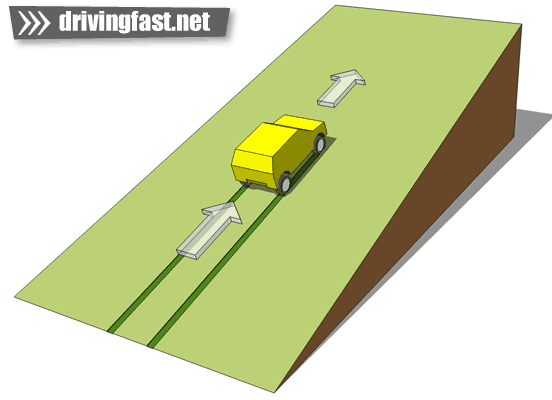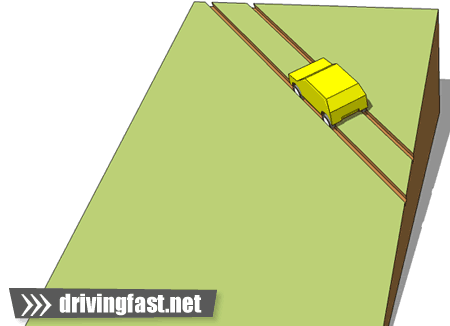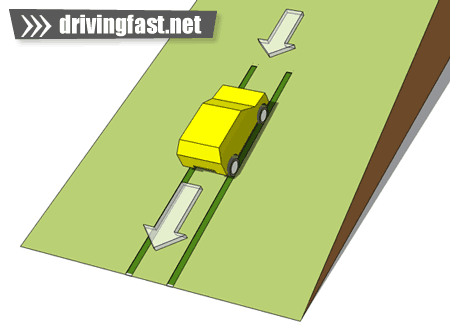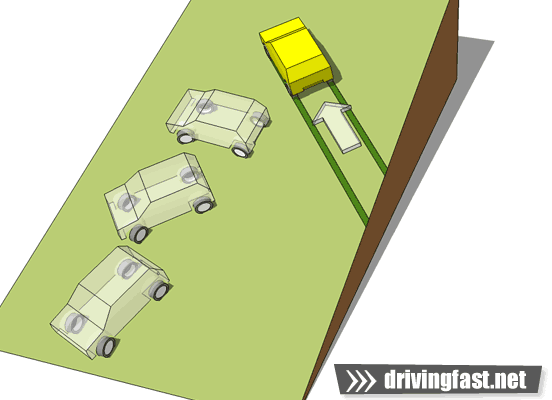Climbing hills
Steep hills can be one of the trickiest obstacles you’re likely to encounter while driving off-road. Not only have you got a gradient to contend with, but gravity is also working against you. It just doesn’t seem fair. However, science is on your side – when attempting the climb for the first time, consider the proven formula for success: A successful climb = the correct route + sufficient traction + sufficient momentum.
- High / Low Range: Low
- Gears: Select the highest practical gear if slippery
- Suspension: Raise if necessary
- Diff lock(s): Engage
- Speed: Momentum may be needed, but ease off at you approach the top
- Note: Be prepared for failure and know how to recover from it
Choose the correct route
The route you pick depends on a number of factors which can be influenced by the following:
- Obstacles such as trees or rocks
- The presence of existing tracks
- Ruts
- Tricky ‘no go’ areas (such as slippery or difficult ground conditions)
The rule of thumb when climbing hills is to attack the slope using a route which minimises any side angles where possible. If you start to slide sideways you’ll have very little control over your vehicle, but sliding forwards or backwards can be controlled. Diagram 1: Driving straight up the hill is the safest route, as it minimises side angles
However, if you’re driving in a rutted track it can be best to stick to the exiting route. If your wheels are positioned in the ruts it’s very unlikely that a sideways slide will occur. Diagram 2: If you’re driving in a rutted track, sliding sideways if unlikely so it’s best to stick in the ruts.
Technique for climbing steep hills [manual transmission vehicle]
- Recce the route on foot – ensure it’s safe to climb, and consider the consequences if you fail half way up. The less grip there is available, the shallower the angle you’ll be able to tackle.
- Once you’re back in the car, hold the car stationary on the foot brake. This acts on all four wheels, and has power assistance, unlike the handbrake which tends to act on the rear wheels only.
- Select a suitable gear for the surface – if the surface is slippery, higher gears provide less torque and thus more traction in slippery conditions. If you’re on a high grip or uneven surface a low gear may be a more sensible choice as it will provide maximum control at low speeds
- Set the throttle – don’t rev the engine, but select engine revs which allow the engine to exploit the power band (3000 rpm is a good guide)
- Progressively release the clutch and do a test run – attempt to climb a few meters of the hill to determine how slippery it is. If you’re getting a lot of wheelspin then you’ll need a fair amount of momentum to complete the climb. If it’s too slippery, perhaps now is the time to find an alternative route.
- If there is sufficient grip, attempt the climb using a run on the flat is necessary. Be prepared to recover from failure (technique described below).
If you start to slide backwards, follow the techniques explained here
Failing to climb
If you’ve failed to make it to the top, the chances are it’s either because of one of the following:
- Lack of grip – if there isn’t enough friction available between the tyre and the ground surface to get you to the top, you’re going to need more momentum. More speed, however means more danger so make sure you’re confident about your decision.
- Lack of momentum – if you fail to get to to the top due to a lack of momentum, you’re likely to stall or simply run out of steam and may even stall the engine. If you do stall, don’t panic and hit the clutch, but follow the guide to recovery shown below.
Recovering from a failed hill climb due to lack of traction or momentum (manual transmission with the engine still running):
- Press and hold the brake pedal firmly
- Look behind you and make sure the coast is clear
- Engage reverse gear
- Release the clutch to the point of bite
- Swiftly but smoothly take your foot off the brake, fully release the clutch, and allow engine braking to slow your descent (avoid the brakes)
- Follow the line which minimises any side slopes – keep the vehicle straight
- Determine whether it’s safe to have another attempt
- Attempt the climb with more speed, using a run up if necessary
If the slope if so slippery that the wheels are locking due to engine braking – you may need to gently apply some throttle to regain traction, then release the throttle gently to re-establish braking.
Recovering from a failed hill climb due to engine stall (manual transmission):
- Hold the vehicle using the foot brake
- Check to see if anyone noticed – this could be embarrassing!
- Clutch in and select reverse gear (engine is still off at this point)
- Release clutch and gently release the foot brake
- Now the car will be held on the slope purely by transmission, and may start to move backwards if the slope is very steep
- Check behind you then restart the engine while in gear (this will ensure engine braking operates from the moment you start to move)
- Avoid using the brakes and reverse down the hill using engine braking for another attempt.
Recovering from a stall in an automatic transmission:
It’s unlikely that you’ll stall an auto, but it can happen. If this does occur, hold the foot brake firmly and restart the engine (you’ll probably need to select N or P first). Now follow the stages shown below. Recovery due to lack of traction or insufficient traction or momentum in an automatic vehicle:
- Press and hold the brake pedal firmly
- Look behind you and make sure the coast is clear
- Engage reverse gear
- Smoothly take your foot off the brake and allow engine braking to slow your descent
- Follow the line which minimises any side slopes – keep the vehicle straight and avoid the brakes
- Determine whether it’s safe to have another attempt
- Attempt the climb with more speed, using a run up if necessary
Recovering from a sideways slide
If you have no choice but to ascend the hill using a side angle, drive as slowly as possible using a light throttle and a high gear to reduce the chances of spinning wheels or a slide. Sometimes a slide is unavoidable and there will be a temporary loss of control. To recover from this situation, you need to heavy end first to allow gravity to help, rather than hinder:
- Do not hit the brakes or press the clutch – this may be your first instinct but will only lock the wheels or disengage the drive
- Steer down the slope to get the heavier front of the car pointing down slope
- If the front refuses to come round, try using some gentle throttle to assist the turn
- One the car is pointing downhill, ensure you are off the gas and allow engine braking to slow the descent




Check to see if anyone noticed – this could be embarrassing!
so true